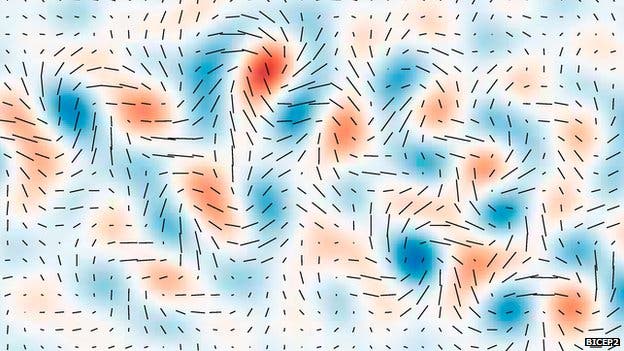The BICEP2 experiment at the South Pole reported the first ever piece of evidence that support the cosmic inflation theory of how the universe cam to be. Their data suggests that scientists have come across signals left over by the super-rapid expansion of space that must have occurred just fractions of a second after everything came into being. Nothing short of extraordinary, the findings will be under intense peer-review scrutiny in the coming months and if indeed found valid by the rest of the scientific community on Earth, this would make it on of the most important discoveries in science.
The confirmation of the Higgs boson – the elementary subparticle that grants fundamental particles mass – was monumental. Now, only a year after its confirmation, the world of physics has a new hallmark discovery that warrants its attention – one that yet again shows that science is on the brink of entering a realm of ‘new’ physics, as some describe.
Some 13.8 billion years ago, the Universe came to existence in a Big Bang. This, at least, is known by most of us, but for scientists researching the genesis of the universe there are still some loose ends. Simply put, many explanations that speculate what the first absolute moments following this cosmic inception looked like are just theories, with little or no tantalizing evidence supporting it. The cosmic inflation theory was first proposed in the 1980s by physicist Alan Guth as a modification to the conventional Big Bang theory. It envisions the formation of the Universe not as a rapidly expanding fireball, instead the universe inflated extremely rapidly from a tiny piece of space and became exponentially larger in a fraction of a second. This idea immediately attracted lots of attention because it could provide a unique solution to many difficult problems of the standard Big Bang theory. As an analogy, the theory holds that in the universe’s very first first trillionth, of a trillionth of a trillionth of a second would have taken something unimaginably small to something about the size of a marble.
An inflating Universe
The BICEP2 telescope is located on the South Pole, where practically you’re the closest you can be to space and still be on the ground. This makes it an ideal place for ground-based observations, in addition to the cold, dry, stable air, which allows for crisp detection of faint cosmic light. The experiment’s main purpose is that of peering through the cosmic microwave background which looms through the whole Universe since the Big Bang. Scientists consider this cosmic background as a form of light since it exhibits all the properties of light, including polarization. While on Earth, polarization of light is caused by the atmosphere which scatters incoming photons, in the case of cosmic radiation, the ‘light’ is scattered by the various atoms and electrons it comes into contact with.
“Our team hunted for a special type of polarization called ‘B-modes,’ which represents a twisting or ‘curl’ pattern in the polarized orientations of the ancient light,” said BICEP2 co-leader Jamie Bock, a professor of physics at Caltech and NASA’s Jet Propulsion Laboratory (JPL).
With much consideration, researchers at the telescope discovered this distinct mode of polarization, which was anticipated by the inflation theory. Namely, the theory followed that cosmic inflation should have been associated with waves of gravitational energy – rippled in the fabric of space that leave tantalizing marks on the cosmic background radiation. Not only this, the signal was reported as being very strong, which makes measurement errors less likely and, at the same time, discredits other theories which predict low signals. The results also constrain the energies involved – at 10,000 trillion gigaelectronvolts. This is consistent with ideas for what is termed Grand Unified Theory, the realm where particle physicists believe three of the four fundamental forces in nature can be tied together.
“This has been like looking for a needle in a haystack, but instead we found a crowbar,” said co-leader Clem Pryke, an associate professor of physics and astronomy at the University of Minnesota.
This is an extraordinary find, but yet it still a claim – not yet confirmed – and like we know, extraordinary claims, require extraordinary evidence. With this in mind, the reputed researchers spent three years carefully shifting through data, tying loose ends and making sure what they found wasn’t a fluke, just some mistake. The scientists did their best, and as far as they’re concerned, they couldn’t find anything that would contradict their measurements and readings. There will be others now that will need to review this work, putting their heads together to find flaws in the research. If deemed fit, well ready that Nobel!
“I can’t tell you how exciting this is,” said Dr Jo Dunkley, who has been searching through data from the European Planck space telescopefor a B-mode signal.
“Inflation sounds like a crazy idea, but everything that is important, everything we see today – the galaxies, the stars, the planets – was imprinted at that moment, in less than a trillionth of a second. If this is confirmed, it’s huge.”
Technical details and journal papers can be found on the BICEP2 release website: http://bicepkeck.org
So, what does Dr. Linde has to say about all this? His reaction is priceless!



